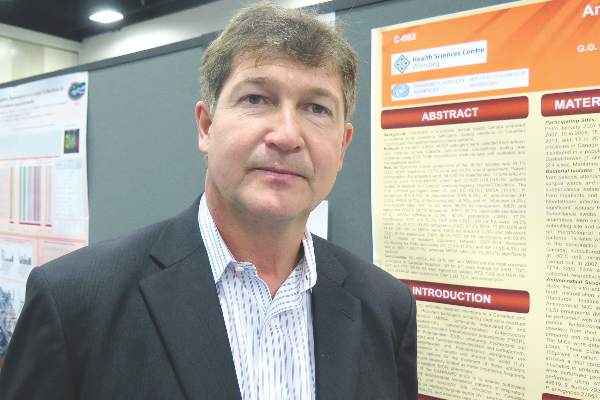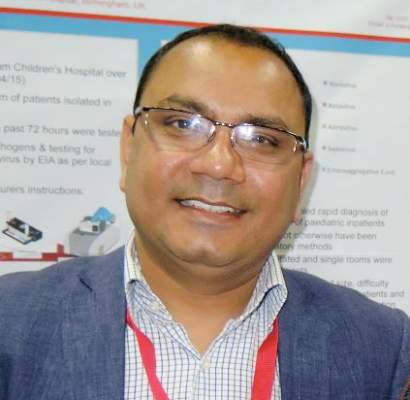User login
Doug Brunk is a San Diego-based award-winning reporter who began covering health care in 1991. Before joining the company, he wrote for the health sciences division of Columbia University and was an associate editor at Contemporary Long Term Care magazine when it won a Jesse H. Neal Award. His work has been syndicated by the Los Angeles Times and he is the author of two books related to the University of Kentucky Wildcats men's basketball program. Doug has a master’s degree in magazine journalism from the S.I. Newhouse School of Public Communications at Syracuse University. Follow him on Twitter @dougbrunk.
In men with HIV, GC/CT infections varied by anatomical site
SAN DIEGO – Among HIV-infected males, positivity rates for gonorrhea and chlamydia infections varied significantly by anatomical site and presence of symptoms, judging from the results from a large, 3-year analysis.
The findings “suggest a need to consider testing multiple sites regardless of reported symptom, possibly depending on reported sexual practice,” Dr. Sarah Rowan said at an annual scientific meeting on infectious diseases.
Guidelines from the Infectious Diseases Society of America and the Centers for Disease Control and Prevention recommend annual urine testing for gonorrhea and chlamydia (GC/CT) for HIV-infected individuals, with the addition of rectal and pharyngeal screening based on report of sexual practice. The investigators explored GC/CT positivity rates by body site and reason for testing in an urban HIV clinic population. They evaluated all GC/CT tests for HIV-infected males at Denver Health from May 2012 through April 2015. On chart review, tests with documented symptoms suggesting GC/CT infection were considered diagnostic tests, while tests without documented symptoms were considered screening tests. The researchers excluded tests with inaccessible medical records and used chi square analysis to examine associations between test results, presence or absence of symptoms, and anatomical test sites.
Results were available from 5,755 tests conducted in 1,232 men with a median age of 44 years. The men had an average of 4.67 tests, most of which were screening tests (81%; the remaining 19% were diagnostic). Among all tests, 5% were positive for GC or CT and a significantly higher proportion of diagnostic tests were positive, compared with screening tests (10% vs. 3%, respectively; P less than .001), reported Dr. Rowan, an internist and pediatrician with the Denver Health and Hospital Authority.
By anatomic site, the majority of all tests were urine tests (65%), followed by those obtained from pharyngeal sites (26%), and rectal sites (9%), while rectal tests were positive more often than pharyngeal or urine tests (10% vs. 5% and 3%, respectively; P less than .001). Combined GC/CT positivity rates were highest for diagnostic rectal (16%) and urine tests (10%) and screening rectal tests (9%).
The researchers also observed that in the absence of symptoms, the most prevalent infection was rectal CT (12%), followed by pharyngeal GC (6%) and rectal GC (6%). Genitourinary symptoms were more often associated with infection in any site, compared with pharyngeal or rectal symptoms (12% vs. 5% and 10%, respectively; P = .115), while rectal tests were positive more often than other anatomic sites regardless of symptom reported.
“Although only 3% of all screening tests were positive, 12% of rectal chlamydia screening tests and 6% of pharyngeal and rectal gonorrhea screening tests were positive, suggesting that screening extragenital sites may identify more infections than screening urine,” Dr. Rowan said.
IDWeek marks the combined annual meetings of the Infectious Diseases Society of America, the Society for Healthcare Epidemiology of America, the HIV Medicine Association, and the Pediatric Infectious Diseases Society. The researchers reported having no financial disclosures.
SAN DIEGO – Among HIV-infected males, positivity rates for gonorrhea and chlamydia infections varied significantly by anatomical site and presence of symptoms, judging from the results from a large, 3-year analysis.
The findings “suggest a need to consider testing multiple sites regardless of reported symptom, possibly depending on reported sexual practice,” Dr. Sarah Rowan said at an annual scientific meeting on infectious diseases.
Guidelines from the Infectious Diseases Society of America and the Centers for Disease Control and Prevention recommend annual urine testing for gonorrhea and chlamydia (GC/CT) for HIV-infected individuals, with the addition of rectal and pharyngeal screening based on report of sexual practice. The investigators explored GC/CT positivity rates by body site and reason for testing in an urban HIV clinic population. They evaluated all GC/CT tests for HIV-infected males at Denver Health from May 2012 through April 2015. On chart review, tests with documented symptoms suggesting GC/CT infection were considered diagnostic tests, while tests without documented symptoms were considered screening tests. The researchers excluded tests with inaccessible medical records and used chi square analysis to examine associations between test results, presence or absence of symptoms, and anatomical test sites.
Results were available from 5,755 tests conducted in 1,232 men with a median age of 44 years. The men had an average of 4.67 tests, most of which were screening tests (81%; the remaining 19% were diagnostic). Among all tests, 5% were positive for GC or CT and a significantly higher proportion of diagnostic tests were positive, compared with screening tests (10% vs. 3%, respectively; P less than .001), reported Dr. Rowan, an internist and pediatrician with the Denver Health and Hospital Authority.
By anatomic site, the majority of all tests were urine tests (65%), followed by those obtained from pharyngeal sites (26%), and rectal sites (9%), while rectal tests were positive more often than pharyngeal or urine tests (10% vs. 5% and 3%, respectively; P less than .001). Combined GC/CT positivity rates were highest for diagnostic rectal (16%) and urine tests (10%) and screening rectal tests (9%).
The researchers also observed that in the absence of symptoms, the most prevalent infection was rectal CT (12%), followed by pharyngeal GC (6%) and rectal GC (6%). Genitourinary symptoms were more often associated with infection in any site, compared with pharyngeal or rectal symptoms (12% vs. 5% and 10%, respectively; P = .115), while rectal tests were positive more often than other anatomic sites regardless of symptom reported.
“Although only 3% of all screening tests were positive, 12% of rectal chlamydia screening tests and 6% of pharyngeal and rectal gonorrhea screening tests were positive, suggesting that screening extragenital sites may identify more infections than screening urine,” Dr. Rowan said.
IDWeek marks the combined annual meetings of the Infectious Diseases Society of America, the Society for Healthcare Epidemiology of America, the HIV Medicine Association, and the Pediatric Infectious Diseases Society. The researchers reported having no financial disclosures.
SAN DIEGO – Among HIV-infected males, positivity rates for gonorrhea and chlamydia infections varied significantly by anatomical site and presence of symptoms, judging from the results from a large, 3-year analysis.
The findings “suggest a need to consider testing multiple sites regardless of reported symptom, possibly depending on reported sexual practice,” Dr. Sarah Rowan said at an annual scientific meeting on infectious diseases.
Guidelines from the Infectious Diseases Society of America and the Centers for Disease Control and Prevention recommend annual urine testing for gonorrhea and chlamydia (GC/CT) for HIV-infected individuals, with the addition of rectal and pharyngeal screening based on report of sexual practice. The investigators explored GC/CT positivity rates by body site and reason for testing in an urban HIV clinic population. They evaluated all GC/CT tests for HIV-infected males at Denver Health from May 2012 through April 2015. On chart review, tests with documented symptoms suggesting GC/CT infection were considered diagnostic tests, while tests without documented symptoms were considered screening tests. The researchers excluded tests with inaccessible medical records and used chi square analysis to examine associations between test results, presence or absence of symptoms, and anatomical test sites.
Results were available from 5,755 tests conducted in 1,232 men with a median age of 44 years. The men had an average of 4.67 tests, most of which were screening tests (81%; the remaining 19% were diagnostic). Among all tests, 5% were positive for GC or CT and a significantly higher proportion of diagnostic tests were positive, compared with screening tests (10% vs. 3%, respectively; P less than .001), reported Dr. Rowan, an internist and pediatrician with the Denver Health and Hospital Authority.
By anatomic site, the majority of all tests were urine tests (65%), followed by those obtained from pharyngeal sites (26%), and rectal sites (9%), while rectal tests were positive more often than pharyngeal or urine tests (10% vs. 5% and 3%, respectively; P less than .001). Combined GC/CT positivity rates were highest for diagnostic rectal (16%) and urine tests (10%) and screening rectal tests (9%).
The researchers also observed that in the absence of symptoms, the most prevalent infection was rectal CT (12%), followed by pharyngeal GC (6%) and rectal GC (6%). Genitourinary symptoms were more often associated with infection in any site, compared with pharyngeal or rectal symptoms (12% vs. 5% and 10%, respectively; P = .115), while rectal tests were positive more often than other anatomic sites regardless of symptom reported.
“Although only 3% of all screening tests were positive, 12% of rectal chlamydia screening tests and 6% of pharyngeal and rectal gonorrhea screening tests were positive, suggesting that screening extragenital sites may identify more infections than screening urine,” Dr. Rowan said.
IDWeek marks the combined annual meetings of the Infectious Diseases Society of America, the Society for Healthcare Epidemiology of America, the HIV Medicine Association, and the Pediatric Infectious Diseases Society. The researchers reported having no financial disclosures.
AT IDWEEK 2015
Key clinical point: Positivity rates for gonorrhea and chlamydia infections in men with HIV vary significantly by anatomical site.
Major finding: Rectal tests for gonorrhea and chlamydia were positive more often than pharyngeal or urine tests (10% vs. 5% and 3%, respectively; P less than .001).
Data source: An analysis of 5,755 tests conducted in 1,232 men with HIV who reside in the Denver area.
Disclosures: The researchers reported having no financial disclosures.
Some 4% of healthy U.S. children carry antibiotic-resistant E. coli isolates
SAN DIEGO – Third-generation cephalosporin-resistant Escherichia coli infection carriage was present in 4.2% of healthy children who underwent stool testing, especially in young children and in those with a household member who traveled internationally within the last year.
Those are key findings from a multicenter study which set out to examine the epidemiology of antibiotic-resistant E. coli colonization in healthy children.
“Overall, the results suggest that there is circulation and spread of third-generation cephalosporin-resistant Escherichia coli infection at the community and global level,” Dr. Shamim M. Islam said at an annual scientific meeting on infectious diseases.
Dr. Islam of the department of pediatrics at the State University of New York at Buffalo characterized the management of extended-spectrum beta-lactamase infections as “particularly complicated in children given limited antibiotic options. ESBL [Extended spectrum beta-lactamase]–producing Enterobacteriaceae infections are steadily rising, including in the community setting.”
As part of the Centers for Disease Control and Prevention’s New Vaccine Surveillance Network acute gastroenteritis project, the researchers enrolled 520 healthy children ranging in age from 14 days to 11 years during well-child visits in Oakland, Calif.; Kansas City, Mo.; and Nashville, Tenn., between December of 2013 and March of 2015. Dr. Islam and his associates administered a four-question survey to parents of the children, including questions about recent antibiotic use in the child and travel and hospitalization history of all members of their household. They collected stool samples from the children and used chromogenic commercial media technology to screen for ESBL-producing bacteria, and also performed confirmatory testing.
Dr. Islam reported that third-generation cephalosporin-resistant E. coli was present in 4.2% of overall stools, with a range from 3.4% to 5.1% among the three study sites. It was found to be more prevalent in children younger than age 5, compared with those aged 5 and older (4.9% vs. 1.7%, respectively; P = .21).
At the Oakland site, 50% of children carrying third-generation cephalosporin-resistant E. coli isolates had a household member who traveled internationally in the past year, compared with 11% of noncarriers (P = .05), while international travel at the other two sites was low. Combined results from those two sites indicated that 18.2% of children carrying third-generation cephalosporin-resistant E. coli isolates had a household member who traveled internationally in the past year, compared with 6.1% of noncarriers (P = .07).
Going forward, the researchers are planning to conduct further genetic and molecular characterization of the isolates they found with mutliplex pCR and whole-genome sequencing. “We’re going to continue surveillance of bacterial carriage at our current three sites for another year to try and expand our risk factor analysis to include more dietary risk factors and more antibiotic exposure,” Dr. Islam said.
IDWeek marks the combined annual meetings of the Infectious Diseases Society of America, the Society for Healthcare Epidemiology of America, the HIV Medicine Association, and the Pediatric Infectious Diseases Society. The researchers reported having no financial disclosures.
SAN DIEGO – Third-generation cephalosporin-resistant Escherichia coli infection carriage was present in 4.2% of healthy children who underwent stool testing, especially in young children and in those with a household member who traveled internationally within the last year.
Those are key findings from a multicenter study which set out to examine the epidemiology of antibiotic-resistant E. coli colonization in healthy children.
“Overall, the results suggest that there is circulation and spread of third-generation cephalosporin-resistant Escherichia coli infection at the community and global level,” Dr. Shamim M. Islam said at an annual scientific meeting on infectious diseases.
Dr. Islam of the department of pediatrics at the State University of New York at Buffalo characterized the management of extended-spectrum beta-lactamase infections as “particularly complicated in children given limited antibiotic options. ESBL [Extended spectrum beta-lactamase]–producing Enterobacteriaceae infections are steadily rising, including in the community setting.”
As part of the Centers for Disease Control and Prevention’s New Vaccine Surveillance Network acute gastroenteritis project, the researchers enrolled 520 healthy children ranging in age from 14 days to 11 years during well-child visits in Oakland, Calif.; Kansas City, Mo.; and Nashville, Tenn., between December of 2013 and March of 2015. Dr. Islam and his associates administered a four-question survey to parents of the children, including questions about recent antibiotic use in the child and travel and hospitalization history of all members of their household. They collected stool samples from the children and used chromogenic commercial media technology to screen for ESBL-producing bacteria, and also performed confirmatory testing.
Dr. Islam reported that third-generation cephalosporin-resistant E. coli was present in 4.2% of overall stools, with a range from 3.4% to 5.1% among the three study sites. It was found to be more prevalent in children younger than age 5, compared with those aged 5 and older (4.9% vs. 1.7%, respectively; P = .21).
At the Oakland site, 50% of children carrying third-generation cephalosporin-resistant E. coli isolates had a household member who traveled internationally in the past year, compared with 11% of noncarriers (P = .05), while international travel at the other two sites was low. Combined results from those two sites indicated that 18.2% of children carrying third-generation cephalosporin-resistant E. coli isolates had a household member who traveled internationally in the past year, compared with 6.1% of noncarriers (P = .07).
Going forward, the researchers are planning to conduct further genetic and molecular characterization of the isolates they found with mutliplex pCR and whole-genome sequencing. “We’re going to continue surveillance of bacterial carriage at our current three sites for another year to try and expand our risk factor analysis to include more dietary risk factors and more antibiotic exposure,” Dr. Islam said.
IDWeek marks the combined annual meetings of the Infectious Diseases Society of America, the Society for Healthcare Epidemiology of America, the HIV Medicine Association, and the Pediatric Infectious Diseases Society. The researchers reported having no financial disclosures.
SAN DIEGO – Third-generation cephalosporin-resistant Escherichia coli infection carriage was present in 4.2% of healthy children who underwent stool testing, especially in young children and in those with a household member who traveled internationally within the last year.
Those are key findings from a multicenter study which set out to examine the epidemiology of antibiotic-resistant E. coli colonization in healthy children.
“Overall, the results suggest that there is circulation and spread of third-generation cephalosporin-resistant Escherichia coli infection at the community and global level,” Dr. Shamim M. Islam said at an annual scientific meeting on infectious diseases.
Dr. Islam of the department of pediatrics at the State University of New York at Buffalo characterized the management of extended-spectrum beta-lactamase infections as “particularly complicated in children given limited antibiotic options. ESBL [Extended spectrum beta-lactamase]–producing Enterobacteriaceae infections are steadily rising, including in the community setting.”
As part of the Centers for Disease Control and Prevention’s New Vaccine Surveillance Network acute gastroenteritis project, the researchers enrolled 520 healthy children ranging in age from 14 days to 11 years during well-child visits in Oakland, Calif.; Kansas City, Mo.; and Nashville, Tenn., between December of 2013 and March of 2015. Dr. Islam and his associates administered a four-question survey to parents of the children, including questions about recent antibiotic use in the child and travel and hospitalization history of all members of their household. They collected stool samples from the children and used chromogenic commercial media technology to screen for ESBL-producing bacteria, and also performed confirmatory testing.
Dr. Islam reported that third-generation cephalosporin-resistant E. coli was present in 4.2% of overall stools, with a range from 3.4% to 5.1% among the three study sites. It was found to be more prevalent in children younger than age 5, compared with those aged 5 and older (4.9% vs. 1.7%, respectively; P = .21).
At the Oakland site, 50% of children carrying third-generation cephalosporin-resistant E. coli isolates had a household member who traveled internationally in the past year, compared with 11% of noncarriers (P = .05), while international travel at the other two sites was low. Combined results from those two sites indicated that 18.2% of children carrying third-generation cephalosporin-resistant E. coli isolates had a household member who traveled internationally in the past year, compared with 6.1% of noncarriers (P = .07).
Going forward, the researchers are planning to conduct further genetic and molecular characterization of the isolates they found with mutliplex pCR and whole-genome sequencing. “We’re going to continue surveillance of bacterial carriage at our current three sites for another year to try and expand our risk factor analysis to include more dietary risk factors and more antibiotic exposure,” Dr. Islam said.
IDWeek marks the combined annual meetings of the Infectious Diseases Society of America, the Society for Healthcare Epidemiology of America, the HIV Medicine Association, and the Pediatric Infectious Diseases Society. The researchers reported having no financial disclosures.
AT IDWEEK 2015
Key clinical point: About 4% of healthy children in the United States harbor antibitotic-resistant E. coli.
Major finding: Third-generation cephalosporin-resistant E. coli was present in 4.2% of overall stools, with a range from 3.4% to 5.1%.
Data source: An analysis of stool samples obtained from 520 healthy children during well-child visits in three different centers in the United States.
Disclosures: The researchers reported having no financial disclosures.
Results mixed in hospital efforts to tackle antimicrobial resistance
SAN DIEGO – Canadian hospitals are making progress in reducing the rates of methicillin-resistant Staphylococcus aureus, but the rates of antimicrobial resistance in Canadian hospitals increased significantly for extended-spectrum beta-lactamase–producing Escherichia coli and Klebsiella pneumoniae, as well as vancomycin-resistant enterococci.
Those are among the key findings from a large national analysis known as CANWARD that were presented at the annual Interscience Conference on Antimicrobial Agents and Chemotherapy. “What it’s telling us is that some of the things that we’re doing on the antimicrobial resistance side are working,” lead study author George G. Zhanel, Pharm.D., professor of microbiology and infectious diseases at the University of Manitoba, Winnipeg, said in an interview. “But it also tells us that some of these pathogens like [vancomycin-resistant enterococci] and [extended-spectrum beta-lactamase]–producing E. coli continue to go up. So there is some good news and some bad news, but it tells us that it’s not all just doom and gloom. Some progress has been made, but there’s still a long way to go.”
Conducted annually, CANWARD is a national health surveillance study that assesses pathogens causing infections in Canadian hospitals and their patterns of antimicrobial resistance. For the current analysis, Dr. Zhanel and his associates collected 36,607 isolates from patients in tertiary care hospitals in Canada from January 2007 to December 2014. They used Clinical and Laboratory Standards Institute broth microdilution methods to perform antimicrobial susceptibility testing on more than 45 marketed and investigational agents.
Slightly more than half of the patients (55%) were male, and 87% were over age 18. The most common pathogens were E. coli (19.7%), methicillin-susceptible Staphylococcus aureus (MSSA; 16.4%), Pseudomonas aeruginosa (8.7%), S. pneumoniae (6.5%), K. pneumoniae (6.1%), methicillin-resistant S. aureus (MRSA; 4.7%), Enterococcus species (4.0%), and Hemophilus influenzae (4.0%). Susceptibility rates for E. coli were 99.9% for meropenem and tigecycline, 99.7% for ertapenem, 97.7% for piperacillin/tazobactam, 92.5% for ceftriaxone, 90.4% for gentamicin, 77.2% for ciprofloxacin, and 73.0% for trimethoprim and sulfamethoxazole. Susceptibility rates for P. aeruginosa were 94.2% for colistin, 84.3% for piperacillin/tazobactam, 83.3% for ceftazidime, 81.2% for meropenem, 77.6% for gentamicin, and 74.1% for ciprofloxacin. Susceptibility rates for MRSA were 100% for linezolid and telavancin, 99.9% for daptomycin, 99.4% for tigecycline, 99.1% for vancomycin, and 93.3% for trimethoprim and sulfamethoxazole. The rates of resistant organisms between 2007 and 2014 increased significantly for extended-spectrum beta-lactamase–producing E. coli (from 3.4% to 11.6%) and K. pneumoniae (from 1.5% to 6.5%), as well as vancomycin-resistant enterococci (from 1.8% to 7.0%), while rates of MRSA significantly declined (from 26.1% to 20.2%).
“The biggest surprise to me is that the hospital-acquired genotype of MRSA is going down,” Dr. Zhanel commented. “The community-acquired genotype is still going up, but the hospital-acquired [genotype] has plummeted in hospitals.”
He noted that CANWARD data suggest that antimicrobial resistance “is not confined to one part of the hospital. We have resistance happening in medical wards, ICUs, and hospital emergency rooms. We consistently find that resistance is highest in the ICU and by far the lowest in the ER. With clinics we find that it’s a variable scenario.”
The study was supported in part by Abbott, Achaogen, Affinium, Astellas, Astra Zeneca, Bayer, Cerexa/Forest, Cubist, Galderma Laboratories, Merck, Paladin Labs, Pfizer/Wyeth, Sunovion, and the Medicines Co. The researchers reported having no relevant financial disclosures.
SAN DIEGO – Canadian hospitals are making progress in reducing the rates of methicillin-resistant Staphylococcus aureus, but the rates of antimicrobial resistance in Canadian hospitals increased significantly for extended-spectrum beta-lactamase–producing Escherichia coli and Klebsiella pneumoniae, as well as vancomycin-resistant enterococci.
Those are among the key findings from a large national analysis known as CANWARD that were presented at the annual Interscience Conference on Antimicrobial Agents and Chemotherapy. “What it’s telling us is that some of the things that we’re doing on the antimicrobial resistance side are working,” lead study author George G. Zhanel, Pharm.D., professor of microbiology and infectious diseases at the University of Manitoba, Winnipeg, said in an interview. “But it also tells us that some of these pathogens like [vancomycin-resistant enterococci] and [extended-spectrum beta-lactamase]–producing E. coli continue to go up. So there is some good news and some bad news, but it tells us that it’s not all just doom and gloom. Some progress has been made, but there’s still a long way to go.”
Conducted annually, CANWARD is a national health surveillance study that assesses pathogens causing infections in Canadian hospitals and their patterns of antimicrobial resistance. For the current analysis, Dr. Zhanel and his associates collected 36,607 isolates from patients in tertiary care hospitals in Canada from January 2007 to December 2014. They used Clinical and Laboratory Standards Institute broth microdilution methods to perform antimicrobial susceptibility testing on more than 45 marketed and investigational agents.
Slightly more than half of the patients (55%) were male, and 87% were over age 18. The most common pathogens were E. coli (19.7%), methicillin-susceptible Staphylococcus aureus (MSSA; 16.4%), Pseudomonas aeruginosa (8.7%), S. pneumoniae (6.5%), K. pneumoniae (6.1%), methicillin-resistant S. aureus (MRSA; 4.7%), Enterococcus species (4.0%), and Hemophilus influenzae (4.0%). Susceptibility rates for E. coli were 99.9% for meropenem and tigecycline, 99.7% for ertapenem, 97.7% for piperacillin/tazobactam, 92.5% for ceftriaxone, 90.4% for gentamicin, 77.2% for ciprofloxacin, and 73.0% for trimethoprim and sulfamethoxazole. Susceptibility rates for P. aeruginosa were 94.2% for colistin, 84.3% for piperacillin/tazobactam, 83.3% for ceftazidime, 81.2% for meropenem, 77.6% for gentamicin, and 74.1% for ciprofloxacin. Susceptibility rates for MRSA were 100% for linezolid and telavancin, 99.9% for daptomycin, 99.4% for tigecycline, 99.1% for vancomycin, and 93.3% for trimethoprim and sulfamethoxazole. The rates of resistant organisms between 2007 and 2014 increased significantly for extended-spectrum beta-lactamase–producing E. coli (from 3.4% to 11.6%) and K. pneumoniae (from 1.5% to 6.5%), as well as vancomycin-resistant enterococci (from 1.8% to 7.0%), while rates of MRSA significantly declined (from 26.1% to 20.2%).
“The biggest surprise to me is that the hospital-acquired genotype of MRSA is going down,” Dr. Zhanel commented. “The community-acquired genotype is still going up, but the hospital-acquired [genotype] has plummeted in hospitals.”
He noted that CANWARD data suggest that antimicrobial resistance “is not confined to one part of the hospital. We have resistance happening in medical wards, ICUs, and hospital emergency rooms. We consistently find that resistance is highest in the ICU and by far the lowest in the ER. With clinics we find that it’s a variable scenario.”
The study was supported in part by Abbott, Achaogen, Affinium, Astellas, Astra Zeneca, Bayer, Cerexa/Forest, Cubist, Galderma Laboratories, Merck, Paladin Labs, Pfizer/Wyeth, Sunovion, and the Medicines Co. The researchers reported having no relevant financial disclosures.
SAN DIEGO – Canadian hospitals are making progress in reducing the rates of methicillin-resistant Staphylococcus aureus, but the rates of antimicrobial resistance in Canadian hospitals increased significantly for extended-spectrum beta-lactamase–producing Escherichia coli and Klebsiella pneumoniae, as well as vancomycin-resistant enterococci.
Those are among the key findings from a large national analysis known as CANWARD that were presented at the annual Interscience Conference on Antimicrobial Agents and Chemotherapy. “What it’s telling us is that some of the things that we’re doing on the antimicrobial resistance side are working,” lead study author George G. Zhanel, Pharm.D., professor of microbiology and infectious diseases at the University of Manitoba, Winnipeg, said in an interview. “But it also tells us that some of these pathogens like [vancomycin-resistant enterococci] and [extended-spectrum beta-lactamase]–producing E. coli continue to go up. So there is some good news and some bad news, but it tells us that it’s not all just doom and gloom. Some progress has been made, but there’s still a long way to go.”
Conducted annually, CANWARD is a national health surveillance study that assesses pathogens causing infections in Canadian hospitals and their patterns of antimicrobial resistance. For the current analysis, Dr. Zhanel and his associates collected 36,607 isolates from patients in tertiary care hospitals in Canada from January 2007 to December 2014. They used Clinical and Laboratory Standards Institute broth microdilution methods to perform antimicrobial susceptibility testing on more than 45 marketed and investigational agents.
Slightly more than half of the patients (55%) were male, and 87% were over age 18. The most common pathogens were E. coli (19.7%), methicillin-susceptible Staphylococcus aureus (MSSA; 16.4%), Pseudomonas aeruginosa (8.7%), S. pneumoniae (6.5%), K. pneumoniae (6.1%), methicillin-resistant S. aureus (MRSA; 4.7%), Enterococcus species (4.0%), and Hemophilus influenzae (4.0%). Susceptibility rates for E. coli were 99.9% for meropenem and tigecycline, 99.7% for ertapenem, 97.7% for piperacillin/tazobactam, 92.5% for ceftriaxone, 90.4% for gentamicin, 77.2% for ciprofloxacin, and 73.0% for trimethoprim and sulfamethoxazole. Susceptibility rates for P. aeruginosa were 94.2% for colistin, 84.3% for piperacillin/tazobactam, 83.3% for ceftazidime, 81.2% for meropenem, 77.6% for gentamicin, and 74.1% for ciprofloxacin. Susceptibility rates for MRSA were 100% for linezolid and telavancin, 99.9% for daptomycin, 99.4% for tigecycline, 99.1% for vancomycin, and 93.3% for trimethoprim and sulfamethoxazole. The rates of resistant organisms between 2007 and 2014 increased significantly for extended-spectrum beta-lactamase–producing E. coli (from 3.4% to 11.6%) and K. pneumoniae (from 1.5% to 6.5%), as well as vancomycin-resistant enterococci (from 1.8% to 7.0%), while rates of MRSA significantly declined (from 26.1% to 20.2%).
“The biggest surprise to me is that the hospital-acquired genotype of MRSA is going down,” Dr. Zhanel commented. “The community-acquired genotype is still going up, but the hospital-acquired [genotype] has plummeted in hospitals.”
He noted that CANWARD data suggest that antimicrobial resistance “is not confined to one part of the hospital. We have resistance happening in medical wards, ICUs, and hospital emergency rooms. We consistently find that resistance is highest in the ICU and by far the lowest in the ER. With clinics we find that it’s a variable scenario.”
The study was supported in part by Abbott, Achaogen, Affinium, Astellas, Astra Zeneca, Bayer, Cerexa/Forest, Cubist, Galderma Laboratories, Merck, Paladin Labs, Pfizer/Wyeth, Sunovion, and the Medicines Co. The researchers reported having no relevant financial disclosures.
AT ICAAC 2015
Key clinical point: In Canadian hospitals, the rate of resistant organisms have increased significantly for E. coli and other pathogens but have decreased for MRSA.
Major finding: Rates of resistant organisms between 2007 and 2014 increased significantly for extended-spectrum beta-lactamase–producing E. coli (from 3.4% to 11.6%) and K. pneumoniae (from 1.5% to 6.5%), as well as vancomycin-resistant enterococci (from 1.8% to 7.0%), while rates of MRSA significantly declined (from 26.1% to 20.2%).
Data source: A lab analysis of 36,607 isolates from patients in tertiary care hospitals in Canada from January 2007 to December 2014.
Disclosures: The study was supported in part by Abbott, Achaogen, Affinium, Astellas, Astra Zeneca, Bayer, Cerexa/Forest, Cubist, Galderma Laboratories, Merck, Paladin Labs, Pfizer/Wyeth, Sunovion, and the Medicines Co. The researchers reported having no relevant financial disclosures.
Peramivir effective against most flu viruses circulating globally
SAN DIEGO – The neuraminidase inhibitor peramivir inhibited about 99% of seasonal influenza A and B viruses circulating globally during the 2013-2014 and 2014-2015 influenza seasons, a large analysis demonstrated.
“The frequency of H1N1pdm09 viruses carrying neuraminidase (NA) H275Y remained low during both seasons; this mutation confers resistance to oseltamivir and peramivir,” said Margaret Okomo-Adhiambo, Ph.D., at the annual Interscience Conference on Antimicrobial Agents and Chemotherapy. In addition, “a small proportion of viruses contained other neuraminidase changes that affect binding of peramivir to viral enzymes and may decrease virus susceptibility. These changes need to be closely monitored.”
Approved by the FDA in December of 2014, peramivir (Rapivab) is the only antiviral agent for influenza treatment to come to market in nearly 20 years. Approved for intravenous administration as a single dose, it is indicated for adults with acute uncomplicated influenza who may have trouble taking orally administered or inhaled neuraminidase (NA) inhibitors. Other NA inhibitors approved by the FDA for influenza infection include oseltamivir, which is orally administered, and zanamivir, which is inhaled.
For the current analysis, Dr. Okomo-Adhiambo of the influenza division at the Centers for Disease Control and Prevention, Atlanta, and her associates tested influenza virus susceptibility to peramivir during the 2013-2014 and 2014-2015 influenza seasons as part of the World Health Organization Global Influenza Surveillance and Response System. A total of 8,426 viruses were tested, 75% of which were circulating in the United States.
Dr. Okomo-Adhiambo reported that during the 2013-2014 and 2014-2015 influenza seasons, about 99% of influenza type A and B viruses were inhibited by peramivir, except for a few viruses belonging to subtype A(H1N1)pdm09 (1.5%), subtype A(H3N2) (0.2%), and type B (0.4%). In addition, NA activity of type A viruses was five to six times more sensitive to inhibition by peramivir, compared with type B NA.
She concluded her presentation by noting that studies “are needed to establish molecular markers of clinically relevant resistance to peramivir.”
The researchers reported having no financial disclosures.
SAN DIEGO – The neuraminidase inhibitor peramivir inhibited about 99% of seasonal influenza A and B viruses circulating globally during the 2013-2014 and 2014-2015 influenza seasons, a large analysis demonstrated.
“The frequency of H1N1pdm09 viruses carrying neuraminidase (NA) H275Y remained low during both seasons; this mutation confers resistance to oseltamivir and peramivir,” said Margaret Okomo-Adhiambo, Ph.D., at the annual Interscience Conference on Antimicrobial Agents and Chemotherapy. In addition, “a small proportion of viruses contained other neuraminidase changes that affect binding of peramivir to viral enzymes and may decrease virus susceptibility. These changes need to be closely monitored.”
Approved by the FDA in December of 2014, peramivir (Rapivab) is the only antiviral agent for influenza treatment to come to market in nearly 20 years. Approved for intravenous administration as a single dose, it is indicated for adults with acute uncomplicated influenza who may have trouble taking orally administered or inhaled neuraminidase (NA) inhibitors. Other NA inhibitors approved by the FDA for influenza infection include oseltamivir, which is orally administered, and zanamivir, which is inhaled.
For the current analysis, Dr. Okomo-Adhiambo of the influenza division at the Centers for Disease Control and Prevention, Atlanta, and her associates tested influenza virus susceptibility to peramivir during the 2013-2014 and 2014-2015 influenza seasons as part of the World Health Organization Global Influenza Surveillance and Response System. A total of 8,426 viruses were tested, 75% of which were circulating in the United States.
Dr. Okomo-Adhiambo reported that during the 2013-2014 and 2014-2015 influenza seasons, about 99% of influenza type A and B viruses were inhibited by peramivir, except for a few viruses belonging to subtype A(H1N1)pdm09 (1.5%), subtype A(H3N2) (0.2%), and type B (0.4%). In addition, NA activity of type A viruses was five to six times more sensitive to inhibition by peramivir, compared with type B NA.
She concluded her presentation by noting that studies “are needed to establish molecular markers of clinically relevant resistance to peramivir.”
The researchers reported having no financial disclosures.
SAN DIEGO – The neuraminidase inhibitor peramivir inhibited about 99% of seasonal influenza A and B viruses circulating globally during the 2013-2014 and 2014-2015 influenza seasons, a large analysis demonstrated.
“The frequency of H1N1pdm09 viruses carrying neuraminidase (NA) H275Y remained low during both seasons; this mutation confers resistance to oseltamivir and peramivir,” said Margaret Okomo-Adhiambo, Ph.D., at the annual Interscience Conference on Antimicrobial Agents and Chemotherapy. In addition, “a small proportion of viruses contained other neuraminidase changes that affect binding of peramivir to viral enzymes and may decrease virus susceptibility. These changes need to be closely monitored.”
Approved by the FDA in December of 2014, peramivir (Rapivab) is the only antiviral agent for influenza treatment to come to market in nearly 20 years. Approved for intravenous administration as a single dose, it is indicated for adults with acute uncomplicated influenza who may have trouble taking orally administered or inhaled neuraminidase (NA) inhibitors. Other NA inhibitors approved by the FDA for influenza infection include oseltamivir, which is orally administered, and zanamivir, which is inhaled.
For the current analysis, Dr. Okomo-Adhiambo of the influenza division at the Centers for Disease Control and Prevention, Atlanta, and her associates tested influenza virus susceptibility to peramivir during the 2013-2014 and 2014-2015 influenza seasons as part of the World Health Organization Global Influenza Surveillance and Response System. A total of 8,426 viruses were tested, 75% of which were circulating in the United States.
Dr. Okomo-Adhiambo reported that during the 2013-2014 and 2014-2015 influenza seasons, about 99% of influenza type A and B viruses were inhibited by peramivir, except for a few viruses belonging to subtype A(H1N1)pdm09 (1.5%), subtype A(H3N2) (0.2%), and type B (0.4%). In addition, NA activity of type A viruses was five to six times more sensitive to inhibition by peramivir, compared with type B NA.
She concluded her presentation by noting that studies “are needed to establish molecular markers of clinically relevant resistance to peramivir.”
The researchers reported having no financial disclosures.
AT ICAAC 2015
Key clinical point: Peramivir is potently effective against seasonal influenza viruses circulating globally.
Major finding: During the 2013-2014 and 2014-2015 influenza seasons, about 99% of influenza type A and B viruses were inhibited by peramivir.
Data source: An analysis of 8,426 influenza viruses that were tested during the 2013-2014 and 2014-2015 influenza seasons as part of the World Health Organization Global Influenza Surveillance and Response System.
Disclosures: The researchers reporting having no financial disclosures.
Simple breath test effectively detected TB
SAN DIEGO – Researchers in England used a novel gas analysis technique to detect tuberculosis in the breath, with a sensitivity of 93% and a specificity of 94%.
“Clearly these are promising results,” Dr. Amandip Sahota said at the annual Interscience Conference on Antimicrobial Agents and Chemotherapy. “What interested me the most is that we were able to detect a significant difference in chemicals in both pulmonary and extra-pulmonary TB, which did indicate to us that the disease does not need to be limited to the lungs to be detectable in the breath.”
According to the latest data from the World Health Organization, there were 9 million active TB cases and 1.5 million deaths from the disease in 2013. Of these deaths, 80,000 were in children.
“TB remains a diagnostic challenge well into the 21st Century,” said Dr. Sahota, a consultant physician in infectious diseases at University Hospitals of Leicester, England. “We are still heavily reliant on the standard culture, which is both slow and resource-intensive throughout the world. Despite the advent of TB-PCR, we are still far away from a diagnostic test which is both available at point of care, at low cost, and is available throughout the world.”
In a study he conducted during his time as a research fellow at the University Hospitals of Coventry, in association with colleagues at the University of Warwick, Dr. Sahota and his associates used a field asymmetric ion mobility spectrometry device to collect samples of exhaled breath from 25 patients with suspected pulmonary or extra-pulmonary TB over a period of 6 months, before or within 1 week of treatment. For comparison, exhaled breath from 19 healthy controls was also obtained.
While ion mobility spectrometry has been used for years by the military and the security industry to detect explosives, for example, the technology has more recently been used to help diagnose medical conditions ranging from cancers to infections.
“Breath testing for TB is not new, but what is very exciting is the advent of newer gas sensor technologies which are being developed in line with a clinical need,” Dr. Sahota explained. “The point of interest here is volatile organic compounds: chemicals which are gaseous at ambient temperatures, often produce odors, and are endogenous products of metabolism in both health and disease states. So testing for breath can be quick, easy, and noninvasive. Clearly there’s plenty of sample. It’s rapid, and it allows access to chemicals in the blood, which are visible in the breath through ventilator processes.”
Patients in the study, which is believed to be the first of its kind, breathed into a 3L Tedlar air sample bag and the samples were tested within 2 hours with a portable field asymmetric ion mobility spectrometry device made by Oxford Immunotec, Inc. After measuring the ionic mobility of volatile organic compounds in the headspace, the researchers determined that the test was highly effective in detecting TB in the breath, with a sensitivity of 93% and a specificity of 94%.
“Clearly this is a small study and we do need to repeat this in a larger cohort to validate it further,” Dr. Sahota said. “We also need to investigate potential confounders such as other comorbidities and medications. Ideally, we’d like to use a smaller, more portable instrument which is ideally hand-held, so we’re exploring commercial partnerships.”
The study was funded by the Medical Research Council. The researchers reported having no financial disclosures.
*This story was updated on 10/5/2015.
SAN DIEGO – Researchers in England used a novel gas analysis technique to detect tuberculosis in the breath, with a sensitivity of 93% and a specificity of 94%.
“Clearly these are promising results,” Dr. Amandip Sahota said at the annual Interscience Conference on Antimicrobial Agents and Chemotherapy. “What interested me the most is that we were able to detect a significant difference in chemicals in both pulmonary and extra-pulmonary TB, which did indicate to us that the disease does not need to be limited to the lungs to be detectable in the breath.”
According to the latest data from the World Health Organization, there were 9 million active TB cases and 1.5 million deaths from the disease in 2013. Of these deaths, 80,000 were in children.
“TB remains a diagnostic challenge well into the 21st Century,” said Dr. Sahota, a consultant physician in infectious diseases at University Hospitals of Leicester, England. “We are still heavily reliant on the standard culture, which is both slow and resource-intensive throughout the world. Despite the advent of TB-PCR, we are still far away from a diagnostic test which is both available at point of care, at low cost, and is available throughout the world.”
In a study he conducted during his time as a research fellow at the University Hospitals of Coventry, in association with colleagues at the University of Warwick, Dr. Sahota and his associates used a field asymmetric ion mobility spectrometry device to collect samples of exhaled breath from 25 patients with suspected pulmonary or extra-pulmonary TB over a period of 6 months, before or within 1 week of treatment. For comparison, exhaled breath from 19 healthy controls was also obtained.
While ion mobility spectrometry has been used for years by the military and the security industry to detect explosives, for example, the technology has more recently been used to help diagnose medical conditions ranging from cancers to infections.
“Breath testing for TB is not new, but what is very exciting is the advent of newer gas sensor technologies which are being developed in line with a clinical need,” Dr. Sahota explained. “The point of interest here is volatile organic compounds: chemicals which are gaseous at ambient temperatures, often produce odors, and are endogenous products of metabolism in both health and disease states. So testing for breath can be quick, easy, and noninvasive. Clearly there’s plenty of sample. It’s rapid, and it allows access to chemicals in the blood, which are visible in the breath through ventilator processes.”
Patients in the study, which is believed to be the first of its kind, breathed into a 3L Tedlar air sample bag and the samples were tested within 2 hours with a portable field asymmetric ion mobility spectrometry device made by Oxford Immunotec, Inc. After measuring the ionic mobility of volatile organic compounds in the headspace, the researchers determined that the test was highly effective in detecting TB in the breath, with a sensitivity of 93% and a specificity of 94%.
“Clearly this is a small study and we do need to repeat this in a larger cohort to validate it further,” Dr. Sahota said. “We also need to investigate potential confounders such as other comorbidities and medications. Ideally, we’d like to use a smaller, more portable instrument which is ideally hand-held, so we’re exploring commercial partnerships.”
The study was funded by the Medical Research Council. The researchers reported having no financial disclosures.
*This story was updated on 10/5/2015.
SAN DIEGO – Researchers in England used a novel gas analysis technique to detect tuberculosis in the breath, with a sensitivity of 93% and a specificity of 94%.
“Clearly these are promising results,” Dr. Amandip Sahota said at the annual Interscience Conference on Antimicrobial Agents and Chemotherapy. “What interested me the most is that we were able to detect a significant difference in chemicals in both pulmonary and extra-pulmonary TB, which did indicate to us that the disease does not need to be limited to the lungs to be detectable in the breath.”
According to the latest data from the World Health Organization, there were 9 million active TB cases and 1.5 million deaths from the disease in 2013. Of these deaths, 80,000 were in children.
“TB remains a diagnostic challenge well into the 21st Century,” said Dr. Sahota, a consultant physician in infectious diseases at University Hospitals of Leicester, England. “We are still heavily reliant on the standard culture, which is both slow and resource-intensive throughout the world. Despite the advent of TB-PCR, we are still far away from a diagnostic test which is both available at point of care, at low cost, and is available throughout the world.”
In a study he conducted during his time as a research fellow at the University Hospitals of Coventry, in association with colleagues at the University of Warwick, Dr. Sahota and his associates used a field asymmetric ion mobility spectrometry device to collect samples of exhaled breath from 25 patients with suspected pulmonary or extra-pulmonary TB over a period of 6 months, before or within 1 week of treatment. For comparison, exhaled breath from 19 healthy controls was also obtained.
While ion mobility spectrometry has been used for years by the military and the security industry to detect explosives, for example, the technology has more recently been used to help diagnose medical conditions ranging from cancers to infections.
“Breath testing for TB is not new, but what is very exciting is the advent of newer gas sensor technologies which are being developed in line with a clinical need,” Dr. Sahota explained. “The point of interest here is volatile organic compounds: chemicals which are gaseous at ambient temperatures, often produce odors, and are endogenous products of metabolism in both health and disease states. So testing for breath can be quick, easy, and noninvasive. Clearly there’s plenty of sample. It’s rapid, and it allows access to chemicals in the blood, which are visible in the breath through ventilator processes.”
Patients in the study, which is believed to be the first of its kind, breathed into a 3L Tedlar air sample bag and the samples were tested within 2 hours with a portable field asymmetric ion mobility spectrometry device made by Oxford Immunotec, Inc. After measuring the ionic mobility of volatile organic compounds in the headspace, the researchers determined that the test was highly effective in detecting TB in the breath, with a sensitivity of 93% and a specificity of 94%.
“Clearly this is a small study and we do need to repeat this in a larger cohort to validate it further,” Dr. Sahota said. “We also need to investigate potential confounders such as other comorbidities and medications. Ideally, we’d like to use a smaller, more portable instrument which is ideally hand-held, so we’re exploring commercial partnerships.”
The study was funded by the Medical Research Council. The researchers reported having no financial disclosures.
*This story was updated on 10/5/2015.
AT ICAAC 2015
Key clinical point: A quick breath test was highly effective in detecting tuberculosis.
Major finding: Using field asymmetric ion mobility spectrometry to detect tuberculosis had a sensitivity of 93% and a specificity of 94%.
Data source: An analysis of volatile active compounds in samples of exhaled breath from 25 patients with suspected pulmonary or extra-pulmonary TB over a period of 6 months.
Disclosures: The study was funded by the Medical Research Council. The researchers reported having no financial disclosures.
Chlorhexidine gel-pad dressing reduces bloodstream infections
SAN DIEGO – Chlorhexidine-containing intravenous catheter securement dressings significantly reduced the incidence of central venous catheter–related bloodstream infections in neutropenic patients, a multicenter randomized trial showed.
“Central venous catheters impose a risk of catheter-related bloodstream infections, especially when used in neutropenic patients, and the mortality risk has been reported to be up to 36%,” Dr. Lena M. Biehl said at the annual Interscience Conference on Antimicrobial Agents and Chemotherapy.
One way to prevent catheter-related bloodstream infections is to use chlorhexidine-containing intravenous catheter securement dressings in an effort to decrease skin colonization, said Dr. Biehl of the department of internal medicine at University Hospital of Cologne (Germany). “A few studies have looked at this, but most of them used chlorhexidine-containing sponges. There’s only one study using a more advanced chlorhexidine-containing gel pad, and this study was done in the ICU setting. The gel pad enables you to evaluate the insertion site, so you can see if there are signs of infection without removing the dressing.”
In a multicenter, randomized trial known as the COAT study that was conducted at 10 hematology departments in Germany from February 2012 to September 2014, Dr. Biehl and her associates set out to compare the incidence of central venous catheter–related bloodstream infections in two groups of neutropenic patients: those with chlorhexidine-containing IV catheter-securement dressings that included a gel pad (the chlorhexidine group) and those with conventional IV catheter-securement dressings that lacked a gel pad (the control group). They limited the analysis to patients undergoing intensive chemotherapy with expected neutropenia for at least 5 days and expected central venous catheter use of at least 10 days. The primary endpoint was the incidence of definite catheter-related bloodstream infections within 14 days of central venous catheter placement. The secondary endpoints were overall incidence of definite or probable central venous catheter–related bloodstream infections at 14 days and the overall incidence of definite or probable central venous catheter–related bloodstream infections.
Dr. Biehl presented results from 613 patients. Of these, 307 were in the chlorhexidine group and 306 were in the control group. The median age was 58 years and 59% were male, and the distribution of causative pathogens was similar between the two groups. The incidence of definite catheter-related bloodstream infections at 14 days was 2.6% in the chlorhexidine group, compared with 3.9% in the control group, a difference that did not reach statistical significance (P = .375). However, the overall incidence of definite and probable central venous catheter–related bloodstream infections together at 14 days was 6.5% in the chlorhexidine group, compared with 11.1% in the control group, a difference that reached statistical significance (P = .047). Finally, the overall incidence of definite and probable central venous catheter–related bloodstream infections was 10.4% in the chlorhexidine group, compared with 17% in the control group, a difference that also reached statistical significance (P = .019).
“The chlorhexidine dressings were very well tolerated, and in contrast to previous studies we saw no increase in skin and soft tissue abnormalities or contact dermatitis,” Dr. Biehl said. The researchers also observed no significant difference in mortality between the chlorhexidine and control groups (6.2 % vs. 5.6%, respectively).
The study was supported by a grant from 3M. Dr. Biehl disclosed that she is a member of the speakers bureau for Astellas Pharma and Merck/MSD. She has received travel grants from 3M and Gilead Sciences. Another study investigator, Dr. Maria J. G. T. Vehreschild, disclosed numerous financial ties to industry.
SAN DIEGO – Chlorhexidine-containing intravenous catheter securement dressings significantly reduced the incidence of central venous catheter–related bloodstream infections in neutropenic patients, a multicenter randomized trial showed.
“Central venous catheters impose a risk of catheter-related bloodstream infections, especially when used in neutropenic patients, and the mortality risk has been reported to be up to 36%,” Dr. Lena M. Biehl said at the annual Interscience Conference on Antimicrobial Agents and Chemotherapy.
One way to prevent catheter-related bloodstream infections is to use chlorhexidine-containing intravenous catheter securement dressings in an effort to decrease skin colonization, said Dr. Biehl of the department of internal medicine at University Hospital of Cologne (Germany). “A few studies have looked at this, but most of them used chlorhexidine-containing sponges. There’s only one study using a more advanced chlorhexidine-containing gel pad, and this study was done in the ICU setting. The gel pad enables you to evaluate the insertion site, so you can see if there are signs of infection without removing the dressing.”
In a multicenter, randomized trial known as the COAT study that was conducted at 10 hematology departments in Germany from February 2012 to September 2014, Dr. Biehl and her associates set out to compare the incidence of central venous catheter–related bloodstream infections in two groups of neutropenic patients: those with chlorhexidine-containing IV catheter-securement dressings that included a gel pad (the chlorhexidine group) and those with conventional IV catheter-securement dressings that lacked a gel pad (the control group). They limited the analysis to patients undergoing intensive chemotherapy with expected neutropenia for at least 5 days and expected central venous catheter use of at least 10 days. The primary endpoint was the incidence of definite catheter-related bloodstream infections within 14 days of central venous catheter placement. The secondary endpoints were overall incidence of definite or probable central venous catheter–related bloodstream infections at 14 days and the overall incidence of definite or probable central venous catheter–related bloodstream infections.
Dr. Biehl presented results from 613 patients. Of these, 307 were in the chlorhexidine group and 306 were in the control group. The median age was 58 years and 59% were male, and the distribution of causative pathogens was similar between the two groups. The incidence of definite catheter-related bloodstream infections at 14 days was 2.6% in the chlorhexidine group, compared with 3.9% in the control group, a difference that did not reach statistical significance (P = .375). However, the overall incidence of definite and probable central venous catheter–related bloodstream infections together at 14 days was 6.5% in the chlorhexidine group, compared with 11.1% in the control group, a difference that reached statistical significance (P = .047). Finally, the overall incidence of definite and probable central venous catheter–related bloodstream infections was 10.4% in the chlorhexidine group, compared with 17% in the control group, a difference that also reached statistical significance (P = .019).
“The chlorhexidine dressings were very well tolerated, and in contrast to previous studies we saw no increase in skin and soft tissue abnormalities or contact dermatitis,” Dr. Biehl said. The researchers also observed no significant difference in mortality between the chlorhexidine and control groups (6.2 % vs. 5.6%, respectively).
The study was supported by a grant from 3M. Dr. Biehl disclosed that she is a member of the speakers bureau for Astellas Pharma and Merck/MSD. She has received travel grants from 3M and Gilead Sciences. Another study investigator, Dr. Maria J. G. T. Vehreschild, disclosed numerous financial ties to industry.
SAN DIEGO – Chlorhexidine-containing intravenous catheter securement dressings significantly reduced the incidence of central venous catheter–related bloodstream infections in neutropenic patients, a multicenter randomized trial showed.
“Central venous catheters impose a risk of catheter-related bloodstream infections, especially when used in neutropenic patients, and the mortality risk has been reported to be up to 36%,” Dr. Lena M. Biehl said at the annual Interscience Conference on Antimicrobial Agents and Chemotherapy.
One way to prevent catheter-related bloodstream infections is to use chlorhexidine-containing intravenous catheter securement dressings in an effort to decrease skin colonization, said Dr. Biehl of the department of internal medicine at University Hospital of Cologne (Germany). “A few studies have looked at this, but most of them used chlorhexidine-containing sponges. There’s only one study using a more advanced chlorhexidine-containing gel pad, and this study was done in the ICU setting. The gel pad enables you to evaluate the insertion site, so you can see if there are signs of infection without removing the dressing.”
In a multicenter, randomized trial known as the COAT study that was conducted at 10 hematology departments in Germany from February 2012 to September 2014, Dr. Biehl and her associates set out to compare the incidence of central venous catheter–related bloodstream infections in two groups of neutropenic patients: those with chlorhexidine-containing IV catheter-securement dressings that included a gel pad (the chlorhexidine group) and those with conventional IV catheter-securement dressings that lacked a gel pad (the control group). They limited the analysis to patients undergoing intensive chemotherapy with expected neutropenia for at least 5 days and expected central venous catheter use of at least 10 days. The primary endpoint was the incidence of definite catheter-related bloodstream infections within 14 days of central venous catheter placement. The secondary endpoints were overall incidence of definite or probable central venous catheter–related bloodstream infections at 14 days and the overall incidence of definite or probable central venous catheter–related bloodstream infections.
Dr. Biehl presented results from 613 patients. Of these, 307 were in the chlorhexidine group and 306 were in the control group. The median age was 58 years and 59% were male, and the distribution of causative pathogens was similar between the two groups. The incidence of definite catheter-related bloodstream infections at 14 days was 2.6% in the chlorhexidine group, compared with 3.9% in the control group, a difference that did not reach statistical significance (P = .375). However, the overall incidence of definite and probable central venous catheter–related bloodstream infections together at 14 days was 6.5% in the chlorhexidine group, compared with 11.1% in the control group, a difference that reached statistical significance (P = .047). Finally, the overall incidence of definite and probable central venous catheter–related bloodstream infections was 10.4% in the chlorhexidine group, compared with 17% in the control group, a difference that also reached statistical significance (P = .019).
“The chlorhexidine dressings were very well tolerated, and in contrast to previous studies we saw no increase in skin and soft tissue abnormalities or contact dermatitis,” Dr. Biehl said. The researchers also observed no significant difference in mortality between the chlorhexidine and control groups (6.2 % vs. 5.6%, respectively).
The study was supported by a grant from 3M. Dr. Biehl disclosed that she is a member of the speakers bureau for Astellas Pharma and Merck/MSD. She has received travel grants from 3M and Gilead Sciences. Another study investigator, Dr. Maria J. G. T. Vehreschild, disclosed numerous financial ties to industry.
AT ICAAC 2015
Key clinical point: Using a chlorhexidine-containing securement dressing reduces the incidence of catheter-related bloodstream infections.
Major finding: The overall incidence of definite and probable central venous catheter–related bloodstream infections was 10.4% in the chlorhexidine group, compared with 17% in the control group, a difference that reached statistical significance (P = .019).
Data source: A randomized study of 613 neutropenic patients conducted at 10 hematology departments in Germany.
Disclosures: The study was supported by a grant from 3M. Dr. Biehl disclosed that she is a member of the speakers bureau for Astellas Pharma and Merck/MSD. She has received travel grants from 3M and Gilead Sciences. Another study investigator, Dr. Maria J. G. T. Vehreschild, disclosed numerous financial ties to industry.
Study tracks long-term mortality risk in MRSA bacteremia patients
SAN DIEGO – Among patients with MRSA bacteremia, age, markers of severity of acute treatment, and duration of treatment are predictive of mortality risk at 90 days and 1 year, a long-term single-center study showed.
At the annual Interscience Conference on Antimicrobial Agents and Chemotherapy, Renee-Claude Mercier, Pharm.D., presented results from an analysis which set out to describe the trajectory and long-term outcomes of patients with MRSA bacteremia, including the influence of bacterial, treatment, and host factors on outcomes.
Dr. Mercier and her associates identified 273 patients who were diagnosed with methicillin-resistant Staphylococcus aureus (MRSA) bacteremia during admission to the University of New Mexico Hospital between 2003 and 2013. The main outcomes were mortality at 90 days and 1 year, while secondary outcomes were hospital readmission, nursing home placement, and continued need for hemodialysis. Dr. Mercier, professor of pharmacy and medicine at the University of New Mexico, Albuquerque, and her associates used multivariable logistic regression and survival analysis to evaluate predictors of outcomes.
The mean age of the 273 patients was 52 years, 71% were male, and USA300 accounted for more than half of the strains (57%). A total of 66 patients (24%) died. “Importantly, we do not know the [mortality] status of 30% of our [study] population,” said Dr. Mercier. “We’re working right now with the [Centers for Disease Control and Prevention] to determine the cause or whether or not some of our patients that were included died in the 365 days following their infection with MRSA.”
At 30 days, the mortality rate was 17.7%, most commonly because of MRSA infection (75% of cases), followed by cancer (6.8% of cases) and secondary infection (2.3% of cases). The researchers followed the patients for a median of 237 days. Nearly half (44.8%) were discharged to home, 40.6% were discharged to a skilled nursing facility, and 2.9% returned to prison. “If patients were to die, they died in the first 30 days after infection with MRSA,” Dr. Mercier said. Independent predictors of mortality at 30 days included older age, the presence of liver disease, an ICU stay, a higher Pitt bacteremia score, and unresolved fever.
When the researchers excluded mortality that occurred in the first 30 days, the mortality rate at 90 days was 5.8%, mainly because of MRSA infection (in 46% of the cases), followed by other infection and unspecified sepsis (9%). On multivariable analysis, independent predictors of mortality at 90 days were use of mechanical ventilation (hazard ratio, 4.8; P = .02) and duration of treatment in days (HR .97; P = .078). “Treatment duration was an important determinant of survival in our study,” Dr. Mercier said. “Whether used as a continuous variable or as a dichotomous variable, using 4 weeks as our cutoff showed that the longer the treatment, the [greater the] decrease in mortality.”
After excluding mortality that occurred in the first 30 days, the researchers found that the mortality rate at 1 year was 17.8%, mainly because of MRSA infection (in 28% of the cases), followed by cancer (in 16% of cases) and secondary infections and unspecified sepsis (in 4% of cases). On multivariable analysis, independent predictors of mortality at 90 days were use of mechanical ventilation (HR 1.04; P = .005) and duration of treatment in days (HR .98; P = .05).
The majority of patients (64%) were not readmitted to the hospital within 1 year, while 16% were readmitted for other types of infections not related to S. aureus. In addition, 4% were readmitted because of cardiovascular causes, and 3% were readmitted because of a S. aureus infection.
Finally, Dr. Mercier and her colleagues performed a competing risk regression analysis examining different factors and their impact on mortality. Having an ICU stay as well as the presence of liver disease and receiving antibiotics for less than 4 weeks were significant predictors of mortality.
The researchers reported having no financial disclosures.
SAN DIEGO – Among patients with MRSA bacteremia, age, markers of severity of acute treatment, and duration of treatment are predictive of mortality risk at 90 days and 1 year, a long-term single-center study showed.
At the annual Interscience Conference on Antimicrobial Agents and Chemotherapy, Renee-Claude Mercier, Pharm.D., presented results from an analysis which set out to describe the trajectory and long-term outcomes of patients with MRSA bacteremia, including the influence of bacterial, treatment, and host factors on outcomes.
Dr. Mercier and her associates identified 273 patients who were diagnosed with methicillin-resistant Staphylococcus aureus (MRSA) bacteremia during admission to the University of New Mexico Hospital between 2003 and 2013. The main outcomes were mortality at 90 days and 1 year, while secondary outcomes were hospital readmission, nursing home placement, and continued need for hemodialysis. Dr. Mercier, professor of pharmacy and medicine at the University of New Mexico, Albuquerque, and her associates used multivariable logistic regression and survival analysis to evaluate predictors of outcomes.
The mean age of the 273 patients was 52 years, 71% were male, and USA300 accounted for more than half of the strains (57%). A total of 66 patients (24%) died. “Importantly, we do not know the [mortality] status of 30% of our [study] population,” said Dr. Mercier. “We’re working right now with the [Centers for Disease Control and Prevention] to determine the cause or whether or not some of our patients that were included died in the 365 days following their infection with MRSA.”
At 30 days, the mortality rate was 17.7%, most commonly because of MRSA infection (75% of cases), followed by cancer (6.8% of cases) and secondary infection (2.3% of cases). The researchers followed the patients for a median of 237 days. Nearly half (44.8%) were discharged to home, 40.6% were discharged to a skilled nursing facility, and 2.9% returned to prison. “If patients were to die, they died in the first 30 days after infection with MRSA,” Dr. Mercier said. Independent predictors of mortality at 30 days included older age, the presence of liver disease, an ICU stay, a higher Pitt bacteremia score, and unresolved fever.
When the researchers excluded mortality that occurred in the first 30 days, the mortality rate at 90 days was 5.8%, mainly because of MRSA infection (in 46% of the cases), followed by other infection and unspecified sepsis (9%). On multivariable analysis, independent predictors of mortality at 90 days were use of mechanical ventilation (hazard ratio, 4.8; P = .02) and duration of treatment in days (HR .97; P = .078). “Treatment duration was an important determinant of survival in our study,” Dr. Mercier said. “Whether used as a continuous variable or as a dichotomous variable, using 4 weeks as our cutoff showed that the longer the treatment, the [greater the] decrease in mortality.”
After excluding mortality that occurred in the first 30 days, the researchers found that the mortality rate at 1 year was 17.8%, mainly because of MRSA infection (in 28% of the cases), followed by cancer (in 16% of cases) and secondary infections and unspecified sepsis (in 4% of cases). On multivariable analysis, independent predictors of mortality at 90 days were use of mechanical ventilation (HR 1.04; P = .005) and duration of treatment in days (HR .98; P = .05).
The majority of patients (64%) were not readmitted to the hospital within 1 year, while 16% were readmitted for other types of infections not related to S. aureus. In addition, 4% were readmitted because of cardiovascular causes, and 3% were readmitted because of a S. aureus infection.
Finally, Dr. Mercier and her colleagues performed a competing risk regression analysis examining different factors and their impact on mortality. Having an ICU stay as well as the presence of liver disease and receiving antibiotics for less than 4 weeks were significant predictors of mortality.
The researchers reported having no financial disclosures.
SAN DIEGO – Among patients with MRSA bacteremia, age, markers of severity of acute treatment, and duration of treatment are predictive of mortality risk at 90 days and 1 year, a long-term single-center study showed.
At the annual Interscience Conference on Antimicrobial Agents and Chemotherapy, Renee-Claude Mercier, Pharm.D., presented results from an analysis which set out to describe the trajectory and long-term outcomes of patients with MRSA bacteremia, including the influence of bacterial, treatment, and host factors on outcomes.
Dr. Mercier and her associates identified 273 patients who were diagnosed with methicillin-resistant Staphylococcus aureus (MRSA) bacteremia during admission to the University of New Mexico Hospital between 2003 and 2013. The main outcomes were mortality at 90 days and 1 year, while secondary outcomes were hospital readmission, nursing home placement, and continued need for hemodialysis. Dr. Mercier, professor of pharmacy and medicine at the University of New Mexico, Albuquerque, and her associates used multivariable logistic regression and survival analysis to evaluate predictors of outcomes.
The mean age of the 273 patients was 52 years, 71% were male, and USA300 accounted for more than half of the strains (57%). A total of 66 patients (24%) died. “Importantly, we do not know the [mortality] status of 30% of our [study] population,” said Dr. Mercier. “We’re working right now with the [Centers for Disease Control and Prevention] to determine the cause or whether or not some of our patients that were included died in the 365 days following their infection with MRSA.”
At 30 days, the mortality rate was 17.7%, most commonly because of MRSA infection (75% of cases), followed by cancer (6.8% of cases) and secondary infection (2.3% of cases). The researchers followed the patients for a median of 237 days. Nearly half (44.8%) were discharged to home, 40.6% were discharged to a skilled nursing facility, and 2.9% returned to prison. “If patients were to die, they died in the first 30 days after infection with MRSA,” Dr. Mercier said. Independent predictors of mortality at 30 days included older age, the presence of liver disease, an ICU stay, a higher Pitt bacteremia score, and unresolved fever.
When the researchers excluded mortality that occurred in the first 30 days, the mortality rate at 90 days was 5.8%, mainly because of MRSA infection (in 46% of the cases), followed by other infection and unspecified sepsis (9%). On multivariable analysis, independent predictors of mortality at 90 days were use of mechanical ventilation (hazard ratio, 4.8; P = .02) and duration of treatment in days (HR .97; P = .078). “Treatment duration was an important determinant of survival in our study,” Dr. Mercier said. “Whether used as a continuous variable or as a dichotomous variable, using 4 weeks as our cutoff showed that the longer the treatment, the [greater the] decrease in mortality.”
After excluding mortality that occurred in the first 30 days, the researchers found that the mortality rate at 1 year was 17.8%, mainly because of MRSA infection (in 28% of the cases), followed by cancer (in 16% of cases) and secondary infections and unspecified sepsis (in 4% of cases). On multivariable analysis, independent predictors of mortality at 90 days were use of mechanical ventilation (HR 1.04; P = .005) and duration of treatment in days (HR .98; P = .05).
The majority of patients (64%) were not readmitted to the hospital within 1 year, while 16% were readmitted for other types of infections not related to S. aureus. In addition, 4% were readmitted because of cardiovascular causes, and 3% were readmitted because of a S. aureus infection.
Finally, Dr. Mercier and her colleagues performed a competing risk regression analysis examining different factors and their impact on mortality. Having an ICU stay as well as the presence of liver disease and receiving antibiotics for less than 4 weeks were significant predictors of mortality.
The researchers reported having no financial disclosures.
AT ICAAC 2015
Key clinical point: Longer treatment for MRSA infection was linked to lower mortality risk.
Major finding: The mortality rate at 1 year was 17.8%, mainly because of MRSA (in 28% of the cases) and cancer (16% of cases).
Data source: A study of 273 patients who were diagnosed with MRSA bacteremia during admission to the University of New Mexico Hospital between 2003 and 2013.
Disclosures: The researchers reported having no financial disclosures.
S. lugdunensis osteoarticular infection often linked to orthopedic devices
SAN DIEGO – Bone and joint infections caused by Staphylococcus lugdunensis are an underestimated hospital-acquired infection often associated with orthopedic devices, according to a multicenter study.
“Consider potential relapse even after 1 year of the end of antibiotic treatment and follow patients with bone and joint infections caused by S. lugdunensis for a minimum 2 years after the end of treatment,” lead study author Dr. Piseth Seng said in an interview at the annual Interscience Conference on Antimicrobial Agents and Chemotherapy.
S. lugdunensis is a virulent coagulase-negative staphylococcus which behaves like S. aureus. Prior to the current study, only 47 cases are believed to be published in the medical literature, according to Dr. Seng of the department of internal medicine at Assistance Publique des Hôpitaux de Marseille (France). The purpose of the current study was to report a series of 138 cases of S. lugdunensis osteoarticular infection managed in nine hospital centers and three private clinics in France from January 1995 to December 2014.
The mean age of patients was 61 years, and 68% were male. Of the 138 cases, 113 (82%) were associated with an orthopedic device, including 2 cases of infection after anterior cruciate ligament reconstruction, 66 cases of prosthetic joint infection, and 3 cases of vertebral orthopedic device infection. The majority of orthopedic device infections (88%) occurred more than 1 month after implantation, while the remaining 12% occurred within the first month of implantation.
The researchers identified 30 cases (22%) of bone and joint infection that occurred in the absence of an orthopedic device, including 7 cases of arthritis, 21 cases of osteitis, and 2 cases of vertebral osteomyelitis.
The majority of patients (91%) received a combination of antibiotic and surgical treatment, including amputation (6%), orthopedic prosthesis removal (14%), internal orthopedic device removal (23%), and surgical debridement and retention of the orthopedic device (41%). The proportion of S. lugdunensis strains with reduced susceptibility to antistaphylococcal agents was low. Resistant strains included five to oxacillin, four to fosfomycin, two to fusidic acid, two to co-trimoxazole, one to rifampicin, and one to clindamycin.
To date, relapses have occurred in 19% of the 123 patients in whom researchers have complete follow-up data. The readmission rate among these patients was 76%, and four (3%) died of their infection. “These relapses were not associated with risk factor or comorbidity or polymicrobial infection,” noted Dr. Seng, who characterized the incidence of bone and joint infections caused by S. lugdunensis as being under reported. “S. lugdunensis is known as an organism forming biofilms, but treatment options (surgical debridement or prosthesis removal) did not influence clinical outcomes.”
The mean time to relapse was 305 days and no risk factor or comorbidity was associated with relapse.
Dr. Seng acknowledged that the study was limited by its retrospective design. He and his associates reported having no financial disclosures.
SAN DIEGO – Bone and joint infections caused by Staphylococcus lugdunensis are an underestimated hospital-acquired infection often associated with orthopedic devices, according to a multicenter study.
“Consider potential relapse even after 1 year of the end of antibiotic treatment and follow patients with bone and joint infections caused by S. lugdunensis for a minimum 2 years after the end of treatment,” lead study author Dr. Piseth Seng said in an interview at the annual Interscience Conference on Antimicrobial Agents and Chemotherapy.
S. lugdunensis is a virulent coagulase-negative staphylococcus which behaves like S. aureus. Prior to the current study, only 47 cases are believed to be published in the medical literature, according to Dr. Seng of the department of internal medicine at Assistance Publique des Hôpitaux de Marseille (France). The purpose of the current study was to report a series of 138 cases of S. lugdunensis osteoarticular infection managed in nine hospital centers and three private clinics in France from January 1995 to December 2014.
The mean age of patients was 61 years, and 68% were male. Of the 138 cases, 113 (82%) were associated with an orthopedic device, including 2 cases of infection after anterior cruciate ligament reconstruction, 66 cases of prosthetic joint infection, and 3 cases of vertebral orthopedic device infection. The majority of orthopedic device infections (88%) occurred more than 1 month after implantation, while the remaining 12% occurred within the first month of implantation.
The researchers identified 30 cases (22%) of bone and joint infection that occurred in the absence of an orthopedic device, including 7 cases of arthritis, 21 cases of osteitis, and 2 cases of vertebral osteomyelitis.
The majority of patients (91%) received a combination of antibiotic and surgical treatment, including amputation (6%), orthopedic prosthesis removal (14%), internal orthopedic device removal (23%), and surgical debridement and retention of the orthopedic device (41%). The proportion of S. lugdunensis strains with reduced susceptibility to antistaphylococcal agents was low. Resistant strains included five to oxacillin, four to fosfomycin, two to fusidic acid, two to co-trimoxazole, one to rifampicin, and one to clindamycin.
To date, relapses have occurred in 19% of the 123 patients in whom researchers have complete follow-up data. The readmission rate among these patients was 76%, and four (3%) died of their infection. “These relapses were not associated with risk factor or comorbidity or polymicrobial infection,” noted Dr. Seng, who characterized the incidence of bone and joint infections caused by S. lugdunensis as being under reported. “S. lugdunensis is known as an organism forming biofilms, but treatment options (surgical debridement or prosthesis removal) did not influence clinical outcomes.”
The mean time to relapse was 305 days and no risk factor or comorbidity was associated with relapse.
Dr. Seng acknowledged that the study was limited by its retrospective design. He and his associates reported having no financial disclosures.
SAN DIEGO – Bone and joint infections caused by Staphylococcus lugdunensis are an underestimated hospital-acquired infection often associated with orthopedic devices, according to a multicenter study.
“Consider potential relapse even after 1 year of the end of antibiotic treatment and follow patients with bone and joint infections caused by S. lugdunensis for a minimum 2 years after the end of treatment,” lead study author Dr. Piseth Seng said in an interview at the annual Interscience Conference on Antimicrobial Agents and Chemotherapy.
S. lugdunensis is a virulent coagulase-negative staphylococcus which behaves like S. aureus. Prior to the current study, only 47 cases are believed to be published in the medical literature, according to Dr. Seng of the department of internal medicine at Assistance Publique des Hôpitaux de Marseille (France). The purpose of the current study was to report a series of 138 cases of S. lugdunensis osteoarticular infection managed in nine hospital centers and three private clinics in France from January 1995 to December 2014.
The mean age of patients was 61 years, and 68% were male. Of the 138 cases, 113 (82%) were associated with an orthopedic device, including 2 cases of infection after anterior cruciate ligament reconstruction, 66 cases of prosthetic joint infection, and 3 cases of vertebral orthopedic device infection. The majority of orthopedic device infections (88%) occurred more than 1 month after implantation, while the remaining 12% occurred within the first month of implantation.
The researchers identified 30 cases (22%) of bone and joint infection that occurred in the absence of an orthopedic device, including 7 cases of arthritis, 21 cases of osteitis, and 2 cases of vertebral osteomyelitis.
The majority of patients (91%) received a combination of antibiotic and surgical treatment, including amputation (6%), orthopedic prosthesis removal (14%), internal orthopedic device removal (23%), and surgical debridement and retention of the orthopedic device (41%). The proportion of S. lugdunensis strains with reduced susceptibility to antistaphylococcal agents was low. Resistant strains included five to oxacillin, four to fosfomycin, two to fusidic acid, two to co-trimoxazole, one to rifampicin, and one to clindamycin.
To date, relapses have occurred in 19% of the 123 patients in whom researchers have complete follow-up data. The readmission rate among these patients was 76%, and four (3%) died of their infection. “These relapses were not associated with risk factor or comorbidity or polymicrobial infection,” noted Dr. Seng, who characterized the incidence of bone and joint infections caused by S. lugdunensis as being under reported. “S. lugdunensis is known as an organism forming biofilms, but treatment options (surgical debridement or prosthesis removal) did not influence clinical outcomes.”
The mean time to relapse was 305 days and no risk factor or comorbidity was associated with relapse.
Dr. Seng acknowledged that the study was limited by its retrospective design. He and his associates reported having no financial disclosures.
AT ICAAC 2015
Key clinical point: S. lugdunensis infections are often associated with orthopedic devices.
Major finding: Of 138 cases of S. lugdunensis osteoarticular infection, 113 (82%) were associated with an orthopedic device.
Data source: A retrospective study of 138 cases of S. lugdunensis osteoarticular infection managed in nine hospitals and three private clinics in France.
Disclosures: The researchers reported having no financial disclosures.
Insomnia not always a clear-cut diagnosis
SAN DIEGO – As if having insomnia or sleep-disordered breathing isn’t challenging enough, some patients turn out to have “complex insomnia” – a combination of moderate/severe insomnia disorders and specific symptoms of sleep-disordered breathing.
“This overlap of insomnia and obstructive sleep apnea is interesting,” Dr. David N. Neubauer said at the annual U.S. Psychiatric and Mental Health Congress.
According to a study of 810 primary care outpatients with no sleep disorder history who presented for nonsleep-related complaints, 82% had at least one insomnia symptom, 36% met criteria for insomnia disorder, 60% had at least one symptom of sleep-disordered breathing, 51% had at least one insomnia symptom and one symptom of sleep-disordered breathing, while 11% had potential complex insomnia: a mix of symptoms meeting criteria for moderate/severe insomnia disorder and specific sleep-disordered breathing (Sleep Med. 2013;14[9]:814-23). Several other studies have demonstrated a strong prevalence of insomnia in obstructive sleep apnea (OSA) patients, “which is not that surprising,” said Dr. Neubauer, associate director of the Johns Hopkins Sleep Disorders Center, Baltimore. However, at least three sleep studies conducted in older patients with insomnia found a high prevalence of OSA. The largest study, of 394 postmenopausal women aged 55-70 years, found that 67% had an apnea-hypopnea index (AHI) of greater than 5.*
In a separate trial, veterans in the Los Angeles area who were at least 60 years old and had seen a Veterans Affairs outpatient provider in the past 2 years were recruited for an insomnia behavioral intervention trial (J Clin Sleep Med. 2013; 9[11]:1173-8). To be eligible for the trial, participants must have had a sleep disturbance with daytime consequences for at least 3 months; those with a history of sleep apnea diagnosis or treatment were excluded. Interventions included questionnaires, a phone interview, and in-home testing with the WatchPAT system, a portable device from Itamar Medical that can help diagnose sleep apnea. The mean age of the 435 community-dwelling participants was 72 years, and their mean body mass index was 28 kg/m2. The researchers found that the prevalence of OSA – defined as an AHI threshold of 15 or greater – was 47%.
In another study from Stanford (Calif.) University, researchers set out to evaluate the impact of a cognitive-behavioral intervention in people with insomnia and major depression (J Psychosom Res. 2009;67[2]:135-41). The screening consisted of a phone interview, in-person screening, and an overnight polysomnography test. The mean age of the 51 people who completed the screening was 48 years, and 57% were female. The researchers found that 69% of patients had an AHI of 5 or greater. Of those, 29% had an AHI between 5 and 15, 24% had an AHI between 15 and 25, while 16% had an AHI of greater than 25. “It must have been frustrating for these researchers to get a ‘clean’ insomnia population, because so many ended up having sleep apnea as part of their underlying problem,” Dr. Neubauer said.
Clinicians might think that the worse the OSA, the worse the insomnia, “but that’s not necessarily the case, because a lot of people with severe OSA are just really sleepy, and they’re sleeping through the next day,” Dr. Neubauer said. Patients with a combination of OSA and insomnia symptoms “tend to be some of the people with milder sleep apnea, or those who are under the radar, who wouldn’t even get diagnosed with OSA, but they have that same physiologic process of some inspiratory flow limitation.” This subset of patients might meet criteria for upper airway resistance syndrome, which was first described in 1993 and is characterized by repetitive increases in resistance to airflow, increased respiratory effort, absence of oxygen desaturation, brief sleep state changes or arousals, and daytime somnolence. “In the sleep community, the diagnosis of upper airway resistance syndrome is somewhat debatable, because some people think that if you don’t have absolute apnea events, they don’t count [as a sleep disorder],” Dr. Neubauer said. “But there are a lot of people who feel that these ‘under the radar’ events may still have a significant effect on sleep.” Compared with OSA patients, those with upper airway resistance syndrome tend to be younger, female, and have a lower body mass index (Respiration 2012;83[6]:559-66). In addition, he said, sleep-onset insomnia is common, and the condition is associated with functional somatic syndromes, such as headache, irritable bowel syndrome, gastroesophageal reflux, rhinitis, and orthostatic intolerance.
A recent analysis of 14 second-generation antidepressants based on Food and Drug Administration data and pharmaceutical company records found that the Top 5 most likely to cause insomnia, compared with placebo, are bupropion, desvenlafaxine, sertraline, fluvoxamine, and fluoxetine (J Clin Psychopharmacol. 2015;35[3]:296-303). The Top 5 most likely to cause somnolence, compared with placebo, are fluvoxamine, mirtazapine, reboxetine, paroxetine, and desvenlafaxine.
According to National Health and Nutrition Examination Survey data from more than 32,000 community-dwelling adults in the United States, 3% of adults took a medication commonly used for insomnia in the previous month – most often zolpidem and trazodone – and use increased between 1999 and 2010 (Sleep 2014;37[2]:343-9). More than half of NHANES participants taking a medication for insomnia (55%) reported taking at least one other sedating medicine concurrently, and 10% reported taking three or more sedating medicines. In addition, 25% reported taking opioids concomitantly, while 20% reported taking benzodiazepines not intended for insomnia. “Concurrent use with medications commonly used for insomnia is high,” Dr. Neubauer said.
He reported having no financial disclosures.
*An earlier version of this story misstated the apnea-hypopnea index (AHI) of 67% of participants in a study.
SAN DIEGO – As if having insomnia or sleep-disordered breathing isn’t challenging enough, some patients turn out to have “complex insomnia” – a combination of moderate/severe insomnia disorders and specific symptoms of sleep-disordered breathing.
“This overlap of insomnia and obstructive sleep apnea is interesting,” Dr. David N. Neubauer said at the annual U.S. Psychiatric and Mental Health Congress.
According to a study of 810 primary care outpatients with no sleep disorder history who presented for nonsleep-related complaints, 82% had at least one insomnia symptom, 36% met criteria for insomnia disorder, 60% had at least one symptom of sleep-disordered breathing, 51% had at least one insomnia symptom and one symptom of sleep-disordered breathing, while 11% had potential complex insomnia: a mix of symptoms meeting criteria for moderate/severe insomnia disorder and specific sleep-disordered breathing (Sleep Med. 2013;14[9]:814-23). Several other studies have demonstrated a strong prevalence of insomnia in obstructive sleep apnea (OSA) patients, “which is not that surprising,” said Dr. Neubauer, associate director of the Johns Hopkins Sleep Disorders Center, Baltimore. However, at least three sleep studies conducted in older patients with insomnia found a high prevalence of OSA. The largest study, of 394 postmenopausal women aged 55-70 years, found that 67% had an apnea-hypopnea index (AHI) of greater than 5.*
In a separate trial, veterans in the Los Angeles area who were at least 60 years old and had seen a Veterans Affairs outpatient provider in the past 2 years were recruited for an insomnia behavioral intervention trial (J Clin Sleep Med. 2013; 9[11]:1173-8). To be eligible for the trial, participants must have had a sleep disturbance with daytime consequences for at least 3 months; those with a history of sleep apnea diagnosis or treatment were excluded. Interventions included questionnaires, a phone interview, and in-home testing with the WatchPAT system, a portable device from Itamar Medical that can help diagnose sleep apnea. The mean age of the 435 community-dwelling participants was 72 years, and their mean body mass index was 28 kg/m2. The researchers found that the prevalence of OSA – defined as an AHI threshold of 15 or greater – was 47%.
In another study from Stanford (Calif.) University, researchers set out to evaluate the impact of a cognitive-behavioral intervention in people with insomnia and major depression (J Psychosom Res. 2009;67[2]:135-41). The screening consisted of a phone interview, in-person screening, and an overnight polysomnography test. The mean age of the 51 people who completed the screening was 48 years, and 57% were female. The researchers found that 69% of patients had an AHI of 5 or greater. Of those, 29% had an AHI between 5 and 15, 24% had an AHI between 15 and 25, while 16% had an AHI of greater than 25. “It must have been frustrating for these researchers to get a ‘clean’ insomnia population, because so many ended up having sleep apnea as part of their underlying problem,” Dr. Neubauer said.
Clinicians might think that the worse the OSA, the worse the insomnia, “but that’s not necessarily the case, because a lot of people with severe OSA are just really sleepy, and they’re sleeping through the next day,” Dr. Neubauer said. Patients with a combination of OSA and insomnia symptoms “tend to be some of the people with milder sleep apnea, or those who are under the radar, who wouldn’t even get diagnosed with OSA, but they have that same physiologic process of some inspiratory flow limitation.” This subset of patients might meet criteria for upper airway resistance syndrome, which was first described in 1993 and is characterized by repetitive increases in resistance to airflow, increased respiratory effort, absence of oxygen desaturation, brief sleep state changes or arousals, and daytime somnolence. “In the sleep community, the diagnosis of upper airway resistance syndrome is somewhat debatable, because some people think that if you don’t have absolute apnea events, they don’t count [as a sleep disorder],” Dr. Neubauer said. “But there are a lot of people who feel that these ‘under the radar’ events may still have a significant effect on sleep.” Compared with OSA patients, those with upper airway resistance syndrome tend to be younger, female, and have a lower body mass index (Respiration 2012;83[6]:559-66). In addition, he said, sleep-onset insomnia is common, and the condition is associated with functional somatic syndromes, such as headache, irritable bowel syndrome, gastroesophageal reflux, rhinitis, and orthostatic intolerance.
A recent analysis of 14 second-generation antidepressants based on Food and Drug Administration data and pharmaceutical company records found that the Top 5 most likely to cause insomnia, compared with placebo, are bupropion, desvenlafaxine, sertraline, fluvoxamine, and fluoxetine (J Clin Psychopharmacol. 2015;35[3]:296-303). The Top 5 most likely to cause somnolence, compared with placebo, are fluvoxamine, mirtazapine, reboxetine, paroxetine, and desvenlafaxine.
According to National Health and Nutrition Examination Survey data from more than 32,000 community-dwelling adults in the United States, 3% of adults took a medication commonly used for insomnia in the previous month – most often zolpidem and trazodone – and use increased between 1999 and 2010 (Sleep 2014;37[2]:343-9). More than half of NHANES participants taking a medication for insomnia (55%) reported taking at least one other sedating medicine concurrently, and 10% reported taking three or more sedating medicines. In addition, 25% reported taking opioids concomitantly, while 20% reported taking benzodiazepines not intended for insomnia. “Concurrent use with medications commonly used for insomnia is high,” Dr. Neubauer said.
He reported having no financial disclosures.
*An earlier version of this story misstated the apnea-hypopnea index (AHI) of 67% of participants in a study.
SAN DIEGO – As if having insomnia or sleep-disordered breathing isn’t challenging enough, some patients turn out to have “complex insomnia” – a combination of moderate/severe insomnia disorders and specific symptoms of sleep-disordered breathing.
“This overlap of insomnia and obstructive sleep apnea is interesting,” Dr. David N. Neubauer said at the annual U.S. Psychiatric and Mental Health Congress.
According to a study of 810 primary care outpatients with no sleep disorder history who presented for nonsleep-related complaints, 82% had at least one insomnia symptom, 36% met criteria for insomnia disorder, 60% had at least one symptom of sleep-disordered breathing, 51% had at least one insomnia symptom and one symptom of sleep-disordered breathing, while 11% had potential complex insomnia: a mix of symptoms meeting criteria for moderate/severe insomnia disorder and specific sleep-disordered breathing (Sleep Med. 2013;14[9]:814-23). Several other studies have demonstrated a strong prevalence of insomnia in obstructive sleep apnea (OSA) patients, “which is not that surprising,” said Dr. Neubauer, associate director of the Johns Hopkins Sleep Disorders Center, Baltimore. However, at least three sleep studies conducted in older patients with insomnia found a high prevalence of OSA. The largest study, of 394 postmenopausal women aged 55-70 years, found that 67% had an apnea-hypopnea index (AHI) of greater than 5.*
In a separate trial, veterans in the Los Angeles area who were at least 60 years old and had seen a Veterans Affairs outpatient provider in the past 2 years were recruited for an insomnia behavioral intervention trial (J Clin Sleep Med. 2013; 9[11]:1173-8). To be eligible for the trial, participants must have had a sleep disturbance with daytime consequences for at least 3 months; those with a history of sleep apnea diagnosis or treatment were excluded. Interventions included questionnaires, a phone interview, and in-home testing with the WatchPAT system, a portable device from Itamar Medical that can help diagnose sleep apnea. The mean age of the 435 community-dwelling participants was 72 years, and their mean body mass index was 28 kg/m2. The researchers found that the prevalence of OSA – defined as an AHI threshold of 15 or greater – was 47%.
In another study from Stanford (Calif.) University, researchers set out to evaluate the impact of a cognitive-behavioral intervention in people with insomnia and major depression (J Psychosom Res. 2009;67[2]:135-41). The screening consisted of a phone interview, in-person screening, and an overnight polysomnography test. The mean age of the 51 people who completed the screening was 48 years, and 57% were female. The researchers found that 69% of patients had an AHI of 5 or greater. Of those, 29% had an AHI between 5 and 15, 24% had an AHI between 15 and 25, while 16% had an AHI of greater than 25. “It must have been frustrating for these researchers to get a ‘clean’ insomnia population, because so many ended up having sleep apnea as part of their underlying problem,” Dr. Neubauer said.
Clinicians might think that the worse the OSA, the worse the insomnia, “but that’s not necessarily the case, because a lot of people with severe OSA are just really sleepy, and they’re sleeping through the next day,” Dr. Neubauer said. Patients with a combination of OSA and insomnia symptoms “tend to be some of the people with milder sleep apnea, or those who are under the radar, who wouldn’t even get diagnosed with OSA, but they have that same physiologic process of some inspiratory flow limitation.” This subset of patients might meet criteria for upper airway resistance syndrome, which was first described in 1993 and is characterized by repetitive increases in resistance to airflow, increased respiratory effort, absence of oxygen desaturation, brief sleep state changes or arousals, and daytime somnolence. “In the sleep community, the diagnosis of upper airway resistance syndrome is somewhat debatable, because some people think that if you don’t have absolute apnea events, they don’t count [as a sleep disorder],” Dr. Neubauer said. “But there are a lot of people who feel that these ‘under the radar’ events may still have a significant effect on sleep.” Compared with OSA patients, those with upper airway resistance syndrome tend to be younger, female, and have a lower body mass index (Respiration 2012;83[6]:559-66). In addition, he said, sleep-onset insomnia is common, and the condition is associated with functional somatic syndromes, such as headache, irritable bowel syndrome, gastroesophageal reflux, rhinitis, and orthostatic intolerance.
A recent analysis of 14 second-generation antidepressants based on Food and Drug Administration data and pharmaceutical company records found that the Top 5 most likely to cause insomnia, compared with placebo, are bupropion, desvenlafaxine, sertraline, fluvoxamine, and fluoxetine (J Clin Psychopharmacol. 2015;35[3]:296-303). The Top 5 most likely to cause somnolence, compared with placebo, are fluvoxamine, mirtazapine, reboxetine, paroxetine, and desvenlafaxine.
According to National Health and Nutrition Examination Survey data from more than 32,000 community-dwelling adults in the United States, 3% of adults took a medication commonly used for insomnia in the previous month – most often zolpidem and trazodone – and use increased between 1999 and 2010 (Sleep 2014;37[2]:343-9). More than half of NHANES participants taking a medication for insomnia (55%) reported taking at least one other sedating medicine concurrently, and 10% reported taking three or more sedating medicines. In addition, 25% reported taking opioids concomitantly, while 20% reported taking benzodiazepines not intended for insomnia. “Concurrent use with medications commonly used for insomnia is high,” Dr. Neubauer said.
He reported having no financial disclosures.
*An earlier version of this story misstated the apnea-hypopnea index (AHI) of 67% of participants in a study.
EXPERT ANALYSIS AT THE 2015 PSYCH CONGRESS
ICAAC: GI PCR test helped infection control in a children’s hospital
SAN DIEGO – Using a multiplex gastrointestinal PCR test known as the GI FilmArray enabled clinicians to rapidly diagnose infective diarrhea at a children’s hospital, allowing them to free up single rooms for patients presenting with other conditions.
“We have shown that this test can be used for infection control purposes,” Dr. Mitul Patel, a consultant microbiologist at Birmingham (England) Children’s Hospital, said in an interview at the annual Interscience Conference on Antimicrobial Agents and Chemotherapy. “People may want to look at this test not just purely from a diagnostic point of view, but as an adjunct to their infection control efforts.”
Manufactured by BioFire Diagnostics, GI FilmArray is a qualitative multiplex gastrointestinal polymerase chain reaction (PCR) which can detect 22 common gastrointestinal pathogens in about 1 hour. Dr. Patel and his associates set out to determine whether diagnosis with the device would facilitate infection control management of pediatric inpatients with diarrhea. “We postulated that if this test is negative, then we have reasonably excluded a pathogenic cause for their diarrhea,” he said. “If the test is negative, then that patient can [safely] be taken out of the isolation and kept on a general ward. In that case, the room can now be used for other patients.”
During a 3-week period in early 2015, the researchers identified 22 patients with a median age of 2 years who were isolated in a single hospital room because of diarrhea. Stool samples obtained from these patients were tested with the GI FilmArray as well as with routine culture for enteric pathogens and testing for Clostridium difficile, rotavirus, and adenovirus by enzyme immunoassay (EIA). Of the 22 patients, 11% (50%) were negative. The GI FilmArray detected a range of pathogens in the remaining 11 patients, including five cases of norovirus, four cases of rotavirus, two cases of Astrovirus, two cases of Sapovirus, and one case of enteroaggregative Escherichia coli. (More than one pathogen was detected in three patients.)
On the other hand, routine culture was negative in all cases, while EIA detected two of the four rotavirus cases that were positive on the GI FilmArray. “By conventional culture and PCR tests, we would have detected only two patients,” Dr. Patel said. “There were nine more patients [for whom] we had an etiological agent known.”
As a result of using the GI FilmArray, two patients were moved out of a single room. “The remaining nine, in spite of having a negative test, still remained in isolation for other reasons,” he said. These included imminent discharge home, protective isolation, and clinician preference.
The researchers acknowledged limitations of the study, including its small sample size, difficulty obtaining stool samples from all symptomatic patients, and the inability of a negative result to fully exclude infection.
They reported having no financial disclosures.
SAN DIEGO – Using a multiplex gastrointestinal PCR test known as the GI FilmArray enabled clinicians to rapidly diagnose infective diarrhea at a children’s hospital, allowing them to free up single rooms for patients presenting with other conditions.
“We have shown that this test can be used for infection control purposes,” Dr. Mitul Patel, a consultant microbiologist at Birmingham (England) Children’s Hospital, said in an interview at the annual Interscience Conference on Antimicrobial Agents and Chemotherapy. “People may want to look at this test not just purely from a diagnostic point of view, but as an adjunct to their infection control efforts.”
Manufactured by BioFire Diagnostics, GI FilmArray is a qualitative multiplex gastrointestinal polymerase chain reaction (PCR) which can detect 22 common gastrointestinal pathogens in about 1 hour. Dr. Patel and his associates set out to determine whether diagnosis with the device would facilitate infection control management of pediatric inpatients with diarrhea. “We postulated that if this test is negative, then we have reasonably excluded a pathogenic cause for their diarrhea,” he said. “If the test is negative, then that patient can [safely] be taken out of the isolation and kept on a general ward. In that case, the room can now be used for other patients.”
During a 3-week period in early 2015, the researchers identified 22 patients with a median age of 2 years who were isolated in a single hospital room because of diarrhea. Stool samples obtained from these patients were tested with the GI FilmArray as well as with routine culture for enteric pathogens and testing for Clostridium difficile, rotavirus, and adenovirus by enzyme immunoassay (EIA). Of the 22 patients, 11% (50%) were negative. The GI FilmArray detected a range of pathogens in the remaining 11 patients, including five cases of norovirus, four cases of rotavirus, two cases of Astrovirus, two cases of Sapovirus, and one case of enteroaggregative Escherichia coli. (More than one pathogen was detected in three patients.)
On the other hand, routine culture was negative in all cases, while EIA detected two of the four rotavirus cases that were positive on the GI FilmArray. “By conventional culture and PCR tests, we would have detected only two patients,” Dr. Patel said. “There were nine more patients [for whom] we had an etiological agent known.”
As a result of using the GI FilmArray, two patients were moved out of a single room. “The remaining nine, in spite of having a negative test, still remained in isolation for other reasons,” he said. These included imminent discharge home, protective isolation, and clinician preference.
The researchers acknowledged limitations of the study, including its small sample size, difficulty obtaining stool samples from all symptomatic patients, and the inability of a negative result to fully exclude infection.
They reported having no financial disclosures.
SAN DIEGO – Using a multiplex gastrointestinal PCR test known as the GI FilmArray enabled clinicians to rapidly diagnose infective diarrhea at a children’s hospital, allowing them to free up single rooms for patients presenting with other conditions.
“We have shown that this test can be used for infection control purposes,” Dr. Mitul Patel, a consultant microbiologist at Birmingham (England) Children’s Hospital, said in an interview at the annual Interscience Conference on Antimicrobial Agents and Chemotherapy. “People may want to look at this test not just purely from a diagnostic point of view, but as an adjunct to their infection control efforts.”
Manufactured by BioFire Diagnostics, GI FilmArray is a qualitative multiplex gastrointestinal polymerase chain reaction (PCR) which can detect 22 common gastrointestinal pathogens in about 1 hour. Dr. Patel and his associates set out to determine whether diagnosis with the device would facilitate infection control management of pediatric inpatients with diarrhea. “We postulated that if this test is negative, then we have reasonably excluded a pathogenic cause for their diarrhea,” he said. “If the test is negative, then that patient can [safely] be taken out of the isolation and kept on a general ward. In that case, the room can now be used for other patients.”
During a 3-week period in early 2015, the researchers identified 22 patients with a median age of 2 years who were isolated in a single hospital room because of diarrhea. Stool samples obtained from these patients were tested with the GI FilmArray as well as with routine culture for enteric pathogens and testing for Clostridium difficile, rotavirus, and adenovirus by enzyme immunoassay (EIA). Of the 22 patients, 11% (50%) were negative. The GI FilmArray detected a range of pathogens in the remaining 11 patients, including five cases of norovirus, four cases of rotavirus, two cases of Astrovirus, two cases of Sapovirus, and one case of enteroaggregative Escherichia coli. (More than one pathogen was detected in three patients.)
On the other hand, routine culture was negative in all cases, while EIA detected two of the four rotavirus cases that were positive on the GI FilmArray. “By conventional culture and PCR tests, we would have detected only two patients,” Dr. Patel said. “There were nine more patients [for whom] we had an etiological agent known.”
As a result of using the GI FilmArray, two patients were moved out of a single room. “The remaining nine, in spite of having a negative test, still remained in isolation for other reasons,” he said. These included imminent discharge home, protective isolation, and clinician preference.
The researchers acknowledged limitations of the study, including its small sample size, difficulty obtaining stool samples from all symptomatic patients, and the inability of a negative result to fully exclude infection.
They reported having no financial disclosures.
AT ICAAC 2015
Key clinical point: GI FilmArray enabled rapid diagnosis of infective diarrhea at a children’s hospital.
Major finding: Of 22 patients tested with the GI FilmArray, 11 (50%) were negative for gastrointestinal pathogens. The majority of cases would not otherwise have been detected by routine laboratory methods.
Data source: A single-center study which set out to determine if use of the GI FilmArray could facilitate infection control management of affected pediatric inpatients.
Disclosures: The researchers reported having no financial disclosures.



















